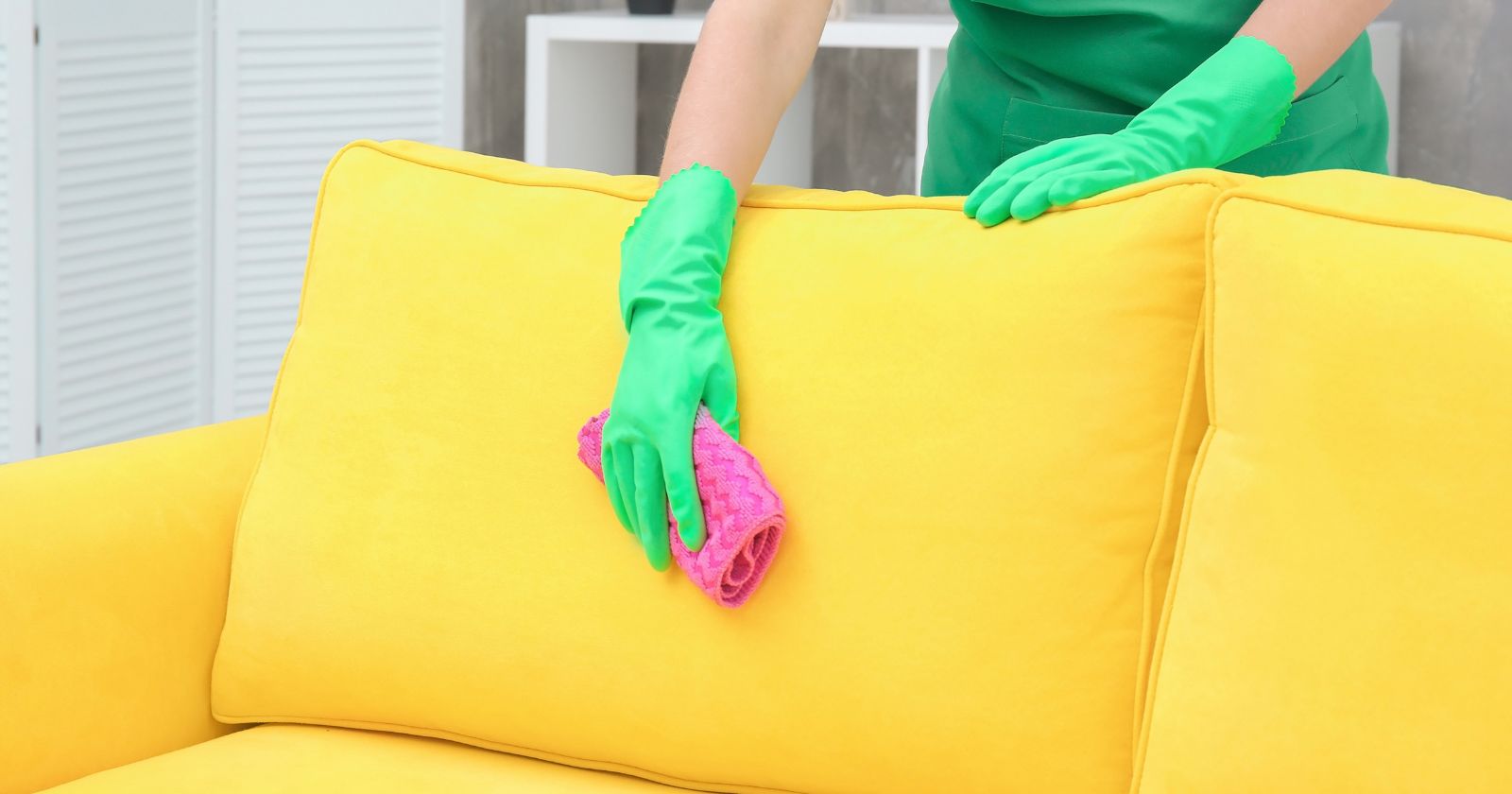Mold on your couch or other fabric furniture is not only disgusting, but the mold spores are also related to an exacerbation of health problems such as allergies.
To keep you and your family safe and to prevent further spread, some cleaning is required. Thankfully, this cleaning can be achieved using simply household products. All that is required are common cleaning materials such as a brush or broom, spray bottle, and water. Needless to say, the earlier you clean your items the easier the process will be.
p.s. you might also want to check out our How to Clean a Couch article if your couch (or chair) has other stains on it.
How to Remove Mildew or Mold From Fabric Furniture
To remove mold from furniture you should expose it to fresh air and sunlight, use a brush and/or vacuum to remove loose mold spores, clean using white vinegar, then rub down with diluted rubbing alcohol to prevent future growth. You must then make changes to the area in which the furniture sits to stop the mold from growing again.
Before getting started, we recommend you invest in a mask and some gloves to protect you from the mold spores and any cleaning materials you will be using. Always test cleaning materials on a small, out-of-the-way area of your upholstery before treating the rest of the piece.
Let’s take a look at those steps in detail:
Step 1: Expose Moldy Furnishings to Fresh Air and Sunlight
Taking your furniture outside and exposing the upholstery to sunlight achieves several objectives. First, moving the upholstery to an open area means you are not brushing off mold spores inside your home, something which isn’t safe as it might encourage further spread and actually increase the number of areas that are affected.
Secondly, if you can get the furniture outside on a nice day, the natural light and breeze can help in removing the mold. The sunlight and wind help to remove moisture from your upholstery and create conditions in which it is hard for mildew to survive.
Choose a nice day with no chance of rain or high humidity and place your furniture outside, in the sunlight. If the furniture is too large or heavy to take outside, remove any part or attachment you can, like couch cushions, and clean them outdoors.
If cleaning your upholstered furniture outside is impossible, put down sheets of paper towel or something similar to catch any mess you make. After you are finished you will need to clean up thoroughly and remove any mildew infected materials.
Step 2: Remove The Mold With Brush, Broom & Vacuum
Use a brush to remove any obvious mold from the couch or fabric upholstery. For larger pieces of upholstery, you could also try using a small broom. Once the brush has cleaned the obvious areas, it is time to vacuum. Use the upholstery attachment of your vacuum and clean the fabric as thoroughly as possible.
Once finished, get rid of the vacuum bag used for cleaning the upholstery. If you use a bagless vacuum, spray the inside with a mold-killing cleaner, like alcohol or vinegar, and wipe it down with a soft cloth. Let the vacuum container dry well before using again.
Step 3: Clean Mold With White Vinegar Spray
White vinegar spray is great for cleaning soft furnishings and will help remove the mold from the surface of your couch or cushion. Put white vinegar into a spray bottle and lightly administer across the whole couch or upholstery. Make sure the cloth doesn’t get too damp-just a light spray. Don’t dilute the vinegar spray with water; it needs to be full strength.
Quick Green Tip: Are you looking to use more sustainable cleaning products? Check out ECOS, Seventh Generation, and Mrs. Meyers on Amazon for some eco-friendly options.
Step 4: Prevent Future Mold Growth By Wiping Down With Rubbing Alcohol Solution
Rubbing alcohol will help prevent mold and mildew from growing on the surface of your couch or other furniture by killing the spores. Mix equal parts rubbing alcohol and water in a bucket or tub. Use a sponge or cloth to wipe the solution gently over the areas affected with mold.
You want to use the solution where needed while avoid adding excess moisture to the furnishing. Water and moisture can exacerbate mold – which is what we’re trying to prevent. Once you have cleaned the couch with equal parts alcohol and water, let the piece dry in sunlight for as long as possible. If this is not possible, open windows to increase air flow or use a dehumidifier.
Please note: rubbing alcohol could stain some materials. Test a small area with the solution first and allow to dry.-If it didn’t damage or stain it is okay to use.
If the upholstery on the couch or fabric isn’t suitable for this mix, you can skip this step and go to cleaning the upholstery using the white vinegar spray solutions. You might even start with a damp cloth and clean off any area that may have mold spots first.
Step 5: Prevent Future Mold Growth By Exposing to Sunlight and Air
To prevent future mold growth you must make your home environment less friendly to mold. Where possible, increase sunlight in the room and decrease humidity. You may need to open windows more often or invest in a dehumidifier. Vacuuming the couch or furnishings more regularly will also help remove spores. If you do not change the conditions in the room, the mold will return.
What’s The Difference Between Mold and Mildew?
Mold and mildew are often used interchangeably, but mildew is actually just one type of mold, which itself is a type of fungi. Mildew grows flat, is often white or grey in color, and can be fluffy or powdery; it appears on damp surfaces. Mold can be a wide range of colors and textures, and often appears when the damp is more severe. On fabric, mold often looks like little white speckles.
Why Does Fabric Get Moldy?
Fabric gets moldy when the environment in which it is situated suits the growth of mold and mildew. A combination of moistness, warmth, and darkness are key factors; a humid environment is perfect for mold spores. Sunlight, good air flow, and regulating humidity are key to preventing this from happening.
You might think that the upholstery on your furniture doesn’t hold a lot of moisture, but you’d be surprised; humidity and poor home insulation make mold growth possible in many homes. You don’t need water dripping on your material to have a problem; moisture in the air may be enough.
Can Mold and Mildew Be Harmful?
Mold and mildew can be harmful. Many people suffer from mold-related allergies, which can cause symptoms such as coughing, running nose, respiratory issues, and dry skin, and range from mild to severe. A reaction to mold or mildew can trigger asthma and exacerbate other conditions.
For this reason it is vital that you clean fabric with mold on in your home; sitting on mold-covered couch upholstery can damage your health as well as your furniture. To prevent this, clean away any mold you see as soon as possible.


